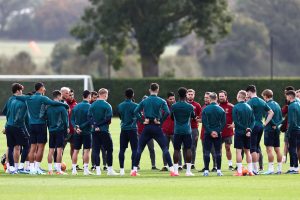In football, it is not only the players who can influence the result, as there are many other elements that have a more or less direct impact on the course and outcome of matches. These elements are included in what we call the ‘meta-game’.
Before starting to analyse the elements that compose the meta-game, it is important to be clear about its meaning, as it refers to everything that indirectly affects the game and that the coach can control. What are these elements? We define them below:
1. Facilities
Refers to the facilities where the team’s practice takes place, not only the team’s own or the opponent’s pitch, but any type of infrastructure of the club itself. Factors such as the height of the grass, the size of the pitch, the age of the infrastructures or the fact of having more or less resources at the service of the athletes will indirectly affect the players and the team.
Image 1. Example of facilities that can be found at a professional club.
2. The club
This is another factor to take into account in the meta-game. In this case, we are not referring to the infrastructure but to the relationship between the club’s management and the team, especially in relation to the sporting results obtained. In this sense, a good or bad relationship between the coaching staff, the sporting management and the players can have consequences on the team’s performance.
A good example of this is Pep Guardiola, who has always shown an excellent relationship with Manchester City’s sporting management, both in good times and bad.
Image 2. Ferran Soriano, Khaldoon Al Mubarak, Pep Guardiola and Txiki Begiristain celebrating a league title win with Manchester City.
3. Match Officials
They are responsible for officiating the game from a neutral standpoint and for making on-the-spot decisions that enforce compliance with the laws of the game. It should be noted that they have a great influence on the match, and even more so with the use of VAR (Video Assistant Referee), which makes it possible to review actions that require a second viewing and can be crucial in the development of the match.
Image 3. A situation from a Premier League match in which the VAR has ruled offside.
4. The fans
This is very important, as a home team can have many advantages or disadvantages due to the effect it has on the players, either by cheering or by being disruptive (booing). That is why coaches and athletes should consider different aspects of their relationship with the fans.
For this, a bond must be created, where both parties share values and behaviours in the different situations that may occur. In addition, they must be made to participate in the match, making them feel important and influential in the game, as more than 25% of fans who go to the stadium to cheer on their team do so out of loyalty and a sense of belonging (Acuña Gómez and Acuña Delgado, 2017).
An example of linking the fans with the team can be through the club’s social networks, encouraging fans to come to the stadium dressed in the team’s colours or by raffling products from the club’s official sponsors.
Image 4. Liverpool fans in the Anfield Road End.
5. The Press Conference
Its expansion across platforms (radio, television and social networks) has facilitated the rapid broadcasting of competitions and sports news, both constituting a medium through which to inform people and creating a relationship between media and sport. Thus, there is influence both from the press to the athletes and vice versa, as the latter can use the press to send messages of any kind: destabilise the opposition, talk about the refereeing, report on the physical and/or emotional state of the team, transmit a message to the fans, etc.
For example, sending a message to the fans through the media to get them to come to the stadium for an important match for the team.
Image 5. Luis Enrique in a press conference with Paris Saint Germain.
6. Environmental Conditions
Preparation for competition requires proper preparation, both physical and mental, a specific nutritional plan and a recovery schedule between training sessions in accordance with the athletes. All these factors are measurable and controllable, but there are different external factors that, if not taken into account, can reduce the performance of athletes.
What do we mean by environmental conditions? Temperature, altitude, rain, fog, wind or snow, for example. All of these can directly affect the team’s performance, either positively or negatively, as is the case in South America, when national teams go to play in Bolivia, at an altitude of over 3,000m, which clearly affects both teams, although in a different way for each one.
All in all, it is clear that it is not only tactics and match planning that will affect the result, but there are other elements that influence the course of the competition and, as coaches, we must be able to control them as much as we can so that their effect on the team is as positive as possible.
Would you like to learn more about high-performance training?
In the Master in High-Performance Football, you will learn in a comprehensive and complete way a training method of tactical preference, which will allow you to deeply understand all the structures of high-performance football. You will apply the basics of structured training and its relationship with the Individual Fundamentals by Position (IFP), and you will discover how to train the team from complex thinking, relating it to the Universal Collective Fundamentals and the Collective Line Fundamentals.












